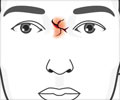Exhaustive research conducted over decades that the human nose has millions of olfactory neurons grouped into hundreds of different neuron types.

For example, when you smell a rose, only those neurons that express a specific odor receptor that detects a chemical the rose emits get activated, which in turn activates a specific region in the brain. Rotten eggs on the other hand, activate a different class of neurons that express a different (rotten egg) receptor and activate a different part of the brain. How the one-receptor-per-neuron pattern — critical for odor discrimination — is achieved in olfactory neurons is a mystery that has frustrated scientists for long.
Now a team of scientists, led by neurobiologists at the University of California, Riverside, has an explanation. Focusing on the olfactory receptor for detecting carbon dioxide in Drosophila (fruit fly), the researchers identified a large multi-protein complex in olfactory neurons, called MMB/dREAM, that plays a major role in selecting the carbon dioxide receptors to be expressed in appropriate neurons.
Study results appear in the Nov. 15 issue of Genes & Development. The research is featured on the cover of the issue.
Braking mechanism
According to the researchers, a molecular mechanism first blocks the expression of most olfactory receptor genes (~60) in the fly's antennae. This mechanism, which acts like a brake, relies on repressive histones —proteins that tightly wrap DNA around them. All insects and mammals are equipped with this mechanism, which keeps the large families of olfactory receptor genes repressed.
Advertisement
Ray explained that one way to understand the mechanism in operation is to consider a typewriter. When none of the keys are pressed, a spring mechanism or "brake" can be imagined to hold the type bars away from the paper. When a key is pressed, however, the brake on that key is overcome and the appropriate letter is typed onto the paper. And just as typing only one letter in one spot is important for each letter to be recognized, expressing one receptor in one neuron lets different sensor types to be generated in the nose.
Advertisement
Next, the researchers will test whether the receptor-braking mechanism they identified in Drosophila is also involved in other organisms like mosquitoes. They also will examine the other receptors in Drosophila to explain what de-represses each one of them.
Modulating response levels
The researchers also found that the activity of the MMB/dREAM multi-protein complex in Drosophila can alter levels of the carbon dioxide receptor and modulate the level of response to carbon dioxide.
"If you dial down the activity of the complex, you also dial down the expression of the carbon dioxide receptors, and the flies cannot sense carbon dioxide effectively," Ray said. "What's particularly encouraging is that this complex is highly conserved in mosquitoes as well, which means that we may be able to dial down the activity of this complex in mosquitoes using genetic strategies, and potentially lower the ability of mosquitoes to sense carbon dioxide, used by them to find human hosts. Because carbon dioxide receptors are so well conserved in mosquitoes, we expect that the regulatory mechanism we discovered in Drosophila may also be acting on mosquito carbon dioxide receptors."
Antenna versus maxillary palp
Interestingly, flies sense carbon dioxide with receptors located in their antennae, and avoid the source. Mosquitoes, on the other hand, are attracted to carbon dioxide and use receptors located not on their antenna but another organ called the maxillary palps (small structures present near the mouthparts). The research team found that two specific proteins in the multi-protein MMB/dREAM complex in mosquitoes have sequences that are quite different from those of the corresponding proteins in Drosophila.
"These proteins — E2F2 and Mip120 — could explain why Drosophila expresses carbon dioxide receptors in the antennae while the mosquito expresses them in its maxillary palp," Ray said.
Source-Eurekalert










